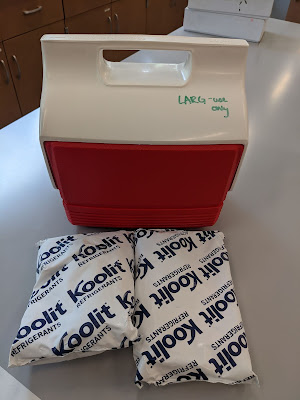E. coli are naturally present in our guts, therefore, we have to avoid any contamination of the samples.
- Put on gloves (make sure the glove bag stays closed as much as possible to avoid contaminants).
- Wipe gloved hands with alcohol.
- Collect water from 1" below the surface in large bottle and pour into small bottle (SHAKE VIGOROUSLY)
- Label bottles with a sharpie (Please make sure the labels are readable for the data person).
- Once collected, samples are put on ice until the are ready to be processed at the lab. The ice ensures that any bacteria in the sample doesn't grow in the meantime. **Samples are processed within SIX hours of collection**
- Rinse large collecting bottle with deionized water for the next site collection (Prevent cross-contamination).
- Place all dirty gloves and trash in provided paper bag.
**Ideally analysis within TWO hours of collection is preferred**






